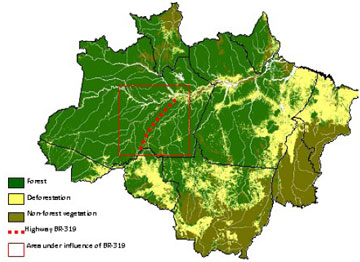Railroad could reduce Amazon deforestation relative to proposed highway
Railroad could reduce Amazon deforestation relative to proposed highway
mongabay.com
March 24, 2008
Building a railroad instead of improving a major highway could reduce deforestation and biodiversity loss in the heart of the Amazon rainforest says an Brazilian environmental group.
The Institute for Conservation and Sustainable Development of Amazonas (IDESAM), together with the state of Amazonas, have teamed up to host a debate on the paving of BR-319, a highway that links the capital cities of Manaus and Porto-Velho, but is presently impassable. Environmentalists say that paving the road could increase deforestation pressures in Amazonas, a state where 98 percent of the forest is still intact.
Instead, IDESAM and Amazon propose building a railway system between the cities.
“Building a railway system would have considerably less impact, avoiding a great deal of the forest loss predicted for the future, while still achieving the economic benefits associated with improving the transportation infrastructure within the Brazilian Amazon,” said IDESAM in a statement.
 This map demonstrates that deforestation up to 2006 (light yellow) is concentrated along roads and waterways. Source: Soares-Filho et al., (Unpublished), based on data from the PRODES Program, Brazilian National Institute for Space Studies |
The railroad would facilitate the transport of goods from Manaus, a major manufacturing center, to the rest of Brazil. At the same time a railway could avoid the deforestation associated with the establishment and improvement of road networks. Settlers, land speculators and developers often use roads to penetrate previously inaccessible forest areas: data from Brazil’s Ministry of the Environment show that from the 1970s to the end of the 1990s, approximately 75 percent of the deforestation in the Amazon occurred near paved roads.
Still, there is intense pressure from development interests to pave the BR-319. Through the Avança Brasil program, Brazil has proposed $43 billion in infrastructure improvement and expansion projects in the region through the year 2020. Improved infrastructure can improve the economic viability of logging, cattle ranching, and agricultural products like soybeans and sugar cane.














